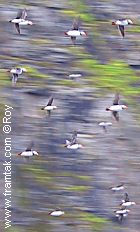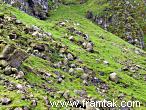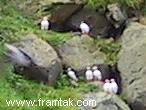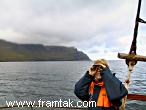 |
Birds in the Faroe Islands |  | HOME |  |
The Atlantic Puffin -
Fratercula arctica Known in Faroes as lundin, the puffin is a well-known character that is understandably one of the star attractions for visitors to Faroes, whether they are keen ornithologist or not.
Known in Faroes as lundin, the puffin is a well-known character that is understandably one of the star attractions for visitors to Faroes, whether they are keen ornithologist or not.
In mid April, the puffin come close to the shore and then at the end of the month comes on land to re-establish its breeding grounds.
It is a pelagic bird - meaning it remains at sea during the winter and only comes ashore to breed. It feeds primarily by diving for fish, but also eats other sea creatures.
 Colonies of these gregarious little entertainers perform on the steep grassy slopes on top of cliffs and rocky stacks where they congregate by their nesting burrows. There is a steady to and fro as they go fishing, leaping into the air frantically flapping their wings, which seem too small for their stocky bodies, and propelling themselves out over the sea into which they plunge. They may look ungainly in the air but they are excellent swimmers and very able to catch their supper.
Colonies of these gregarious little entertainers perform on the steep grassy slopes on top of cliffs and rocky stacks where they congregate by their nesting burrows. There is a steady to and fro as they go fishing, leaping into the air frantically flapping their wings, which seem too small for their stocky bodies, and propelling themselves out over the sea into which they plunge. They may look ungainly in the air but they are excellent swimmers and very able to catch their supper.
After the hard working parents have, hopefully, raised their one puffling and it is ready to brave the launch out over the vast open ocean, the colonies prepare to leave and they head out to sea in the last half of August. If the pufflings survive the challenges of growing into adulthood they can live into their late 20s.
Puffins can be seen carrying many fish in their bills. Usually it is 5-10 fish, but sometimes it is many more. According to the Royal Society for the protection of Birds in the UK, the maximum recorded beakful is 62 fish, mostly sand-eels.
2006
Reports from the islands of Nólsoy, Skúvoy and Mykines all show that the number of puffins, guillemots and razorbills seen in 2006 was much lower than normal and this is believed to be because of lack of food.
|
The photos at the top of the page are: 1. Steep grassy slopes covered in puffins 2. Puffins in the Faroe Islands 3. Viewing the bird cliffs |
 Copyright Copyright © 1997 - 2013 Framtak, FO-650 Toftir, Faroe Islands |
|
|

|



